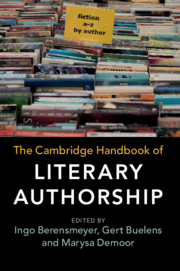Book contents
- The Cambridge Handbook of Literary Authorship
- The Cambridge Handbook of Literary Authorship
- Copyright page
- Contents
- Figures
- Contributors
- Acknowledgments
- Abbreviations
- Chapter 1 Introduction
- Part I Historical Perspectives
- Chapter 2 Authorship in Cuneiform Literature
- Chapter 3 Authorship in Ancient Egypt
- Chapter 4 Authorship in Archaic and Classical Greece
- Chapter 5 Authorship in Classical Rome
- Chapter 6 Conceptions of Authorship in Early Jewish Cultures
- Chapter 7 Modes of Authorship and the Making of Medieval English Literature
- Chapter 8 Manuscript and Print Cultures 1500–1700
- Chapter 9 The Eighteenth Century
- Chapter 10 The Nineteenth Century
- Chapter 11 Industrialized Print
- Chapter 12 Postmodernist Authorship
- Chapter 13 Chinese Authorship
- Chapter 14 Literary Authorship in the Digital Age
- Part II Systematic Perspectives
- Part III Practical Perspectives
- Select Bibliography
- Index
Chapter 11 - Industrialized Print
Modernism and Authorship
from Part I - Historical Perspectives
Published online by Cambridge University Press: 07 June 2019
- The Cambridge Handbook of Literary Authorship
- The Cambridge Handbook of Literary Authorship
- Copyright page
- Contents
- Figures
- Contributors
- Acknowledgments
- Abbreviations
- Chapter 1 Introduction
- Part I Historical Perspectives
- Chapter 2 Authorship in Cuneiform Literature
- Chapter 3 Authorship in Ancient Egypt
- Chapter 4 Authorship in Archaic and Classical Greece
- Chapter 5 Authorship in Classical Rome
- Chapter 6 Conceptions of Authorship in Early Jewish Cultures
- Chapter 7 Modes of Authorship and the Making of Medieval English Literature
- Chapter 8 Manuscript and Print Cultures 1500–1700
- Chapter 9 The Eighteenth Century
- Chapter 10 The Nineteenth Century
- Chapter 11 Industrialized Print
- Chapter 12 Postmodernist Authorship
- Chapter 13 Chinese Authorship
- Chapter 14 Literary Authorship in the Digital Age
- Part II Systematic Perspectives
- Part III Practical Perspectives
- Select Bibliography
- Index
Summary
We now imagine ourselves to be living in an age of nearly frictionless authorship, one in which ideas – both wild and mundane – can be instantly published on a blog, in a Facebook comment, or on platforms from Reddit to Amazon that thrive on what we still awkwardly refer to as “self-published” manuscripts. Authorship – whether defined broadly as the mere production of text or more narrowly as the creation of a work of art – has become ubiquitous. Rapid developments in the field of artificial intelligence, moreover, have eerily extended authorship into the realm of objects and machines: nefarious “bots” flood Twitter streams and, in 2016, an algorithmically generated science-fiction novel advanced past the first round of cuts for the Hoshi Shinichi Literary Award.1 The origin of such ubiquitous authorship cannot be dated exactly, but its effects registered vividly on the cluttered newsstands of the 1920s, where hundreds of magazines, newspapers, paperbacks, gazettes, pamphlets, and books jostled with one another for attention.
- Type
- Chapter
- Information
- The Cambridge Handbook of Literary Authorship , pp. 165 - 182Publisher: Cambridge University PressPrint publication year: 2019
- 1
- Cited by

